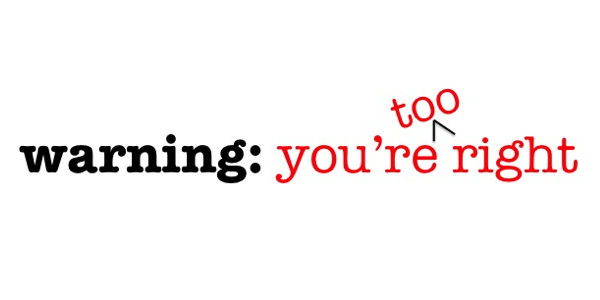"Confidence comes not from always being right but from not fearing to be wrong.”
Peter T. Mcintyre
![]()
“NOOO. You’re WRONG. I’m RIGHT”, Matt insisted.
Matt and I were reviewing his analysis.
Matt’s assessment was that results were down 5%. I disagreed. My assessment was the results were up 25% with some promotional variation. But Matt kept insisting that results were down 5%.
Technically Matt was right. Results were down 5% in a two week period last month. But overall results improved by 25% over the past 6 months. Matt's conclusion was due to a temporary and predicted dip after running a promotion. We argued for a few minutes.
Finally I conceded on his technicality and Matt was happy. He won his battle and was "RIGHT."
BUT Matt lost the war...
...on credibility.
Matt was a smart analyst. But he didn’t always understand the big picture and sometimes he took things out of context. He also didn’t like to be told he was wrong and would become defensive. He was easily distracted by "right and wrong" and often fought for his position if he felt threatened, even if it cost him his credibility.
I get it. I understand the battle between right and wrong.
I like to be right.
I hate to be wrong.
But...
I've learned there's a wrong way to be right.
![]()
The wrong way to be right is to be right for the sake of being right. Leaders need to consider if being right is worth sacrificing the big picture: Credibility. Business progress. Collaboration.
If you or someone you know is struggling with the line between right and "too" right, here are some tips to consider.
-
Always think about the big picture. When you're presenting, or making an argument, make reference to the objectives you're trying to achieve.
"Our objective is to understand if our marketing plan is driving sales. Overall sales are up 25% in the past 6 months. But we need to be aware of temporary dips as high as 5% after promotions."
-
Prepare for potential concerns. If you are going into a meeting where you may have disagreement, do some prep work. Meet with your boss or co-worker about potential hot spots and discuss how to handle disagreements.
-
Acknowledge the person's point, and make sure you understand his position before your react. Don't start a fight over a misunderstanding. Articulate your understanding of the other person's point, "Did I understand what you were trying to say? Let me play back what I heard."
-
Ask for context if someone disagrees with you. Instead of immediately disagreeing or becoming defensive, ask for clarification, "Will you give me more background on that? That's not the way I understand it, but we could be looking at it differently."
BONUS: You can build a bridge between potentially different points of view.
-
If you start to feel defensive, don't respond right away. Take a break, or if possible, ask, if it's ok to do some more research and get back with them. Try not to take everything personally and use a cooling off period if you need one.
A successful career is not a score of how many times you're right versus wrong.
In business you can be wrong and still win. BUT you can also be right and lose. So instead of keeping score, keep focused on meeting your business objectives. And instead of being too right, you'll be just right.
Looking for more on leadership? Take a look at this popular posts on Evoke.
- The Simple Secret of Earning Influence
- How NOT To Listen - One Habit that's Not Helping You
- Why Your Team Won't Follow You
Check out the The Career Toolbox page for more practical tips and tools.
Follow Evoke.pro on LinkedIn.
Imagery/Rebecca Okamoto

